Sustainable Tourism Development in Egypt: Analysis and Strategies
VerifiedAdded on 2021/01/02
|16
|4937
|301
Report
AI Summary
This report examines sustainable tourism development within the context of Egypt's tourism industry. It begins by outlining the benefits various stakeholders, including the government, travel operators, and local communities, derive from tourism development. It then analyzes the advantages and disadvantages of public-private partnerships in tourism planning. The report delves into the features of tourism development planning at international, national, and regional levels, emphasizing the significance of interactive planning programs. Methods for measuring tourist impact are discussed, along with the justification for sustainability in tourism development and factors that may hinder it. The report explores conflict resolution strategies, the implications of managing supply and demand, and ethical considerations within enclave tourism. Finally, the report compares tourism development in Egypt with that of other developing countries and provides recommendations for future improvements.
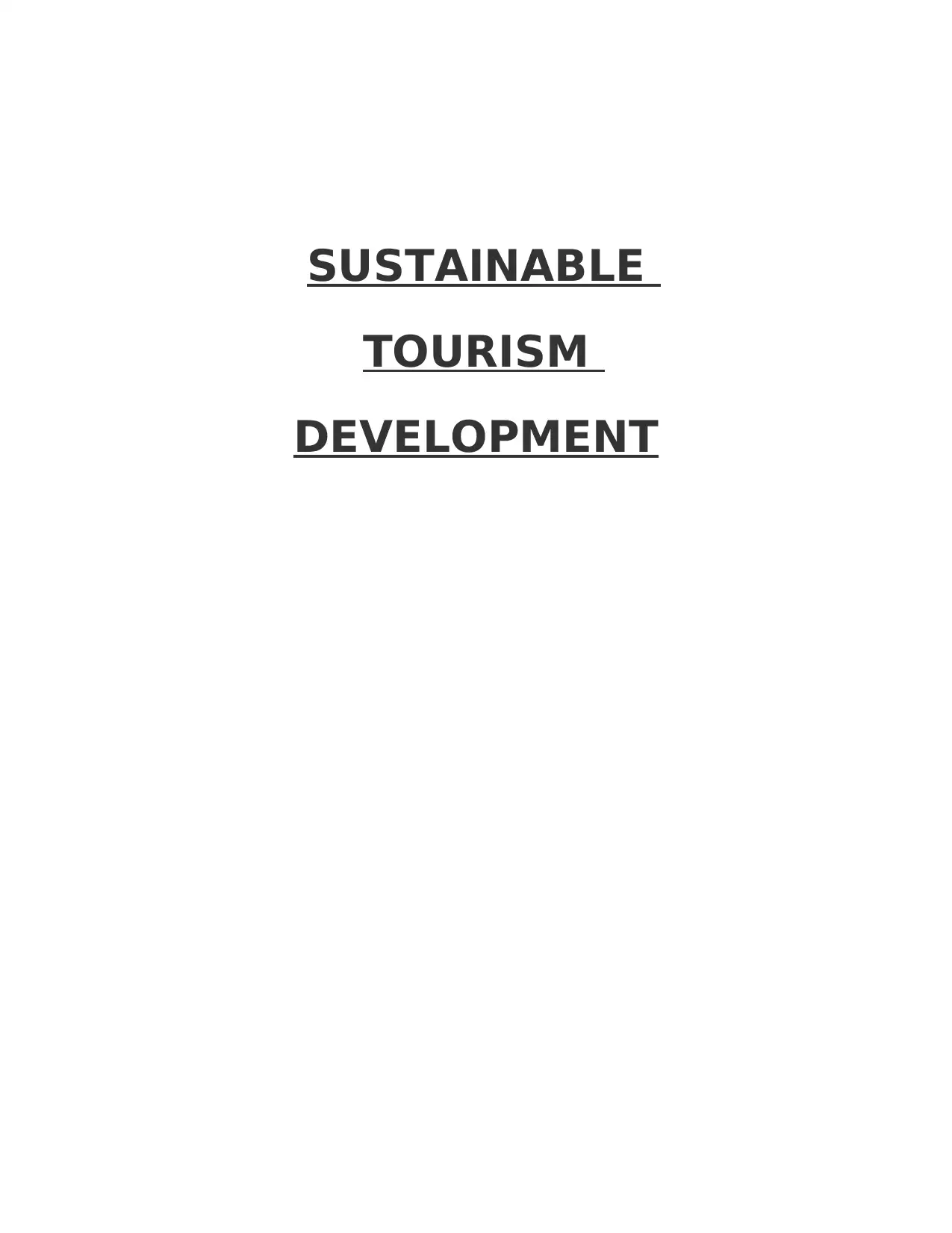
SUSTAINABLE
TOURISM
DEVELOPMENT
TOURISM
DEVELOPMENT
Paraphrase This Document
Need a fresh take? Get an instant paraphrase of this document with our AI Paraphraser
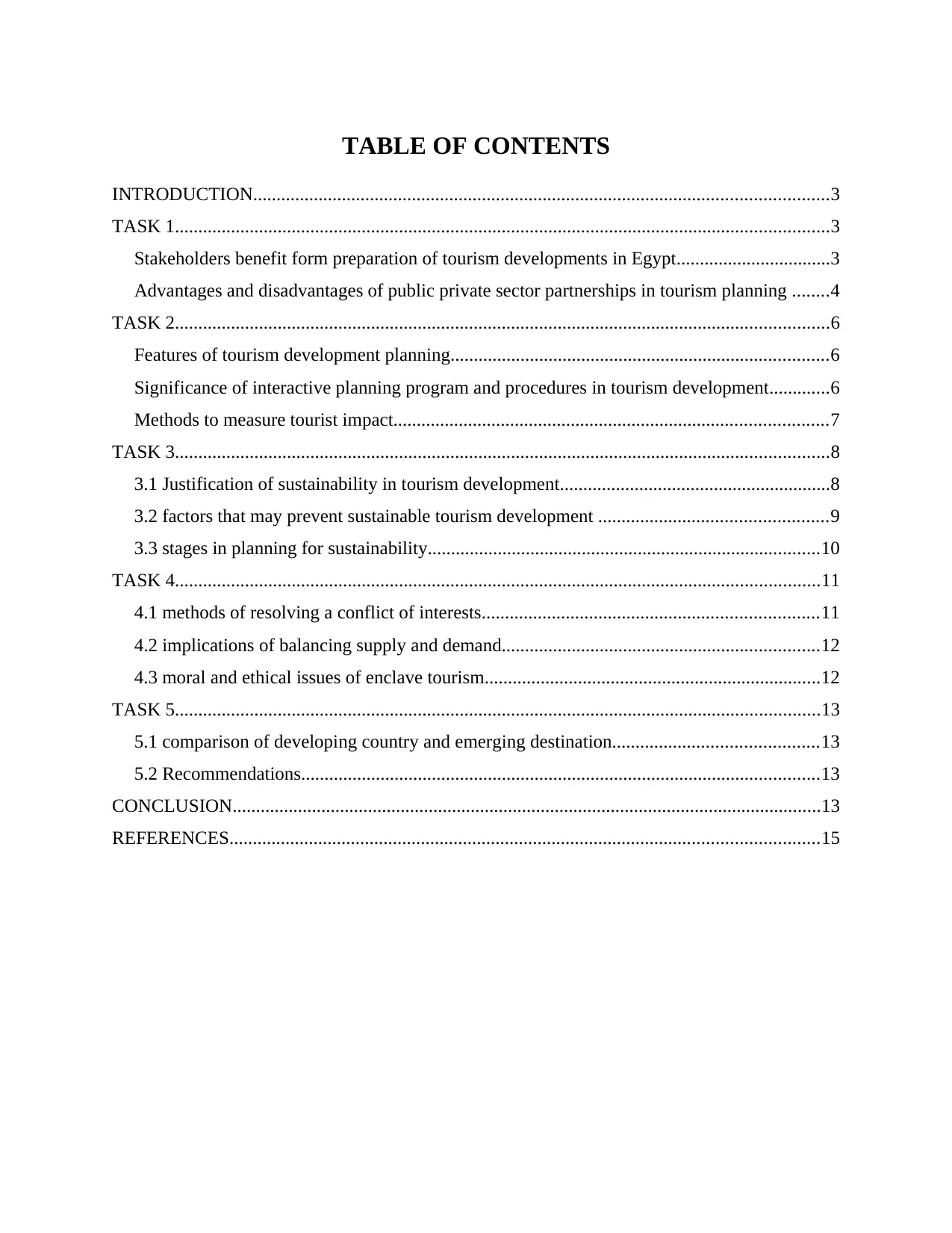
TABLE OF CONTENTS
INTRODUCTION...........................................................................................................................3
TASK 1............................................................................................................................................3
Stakeholders benefit form preparation of tourism developments in Egypt.................................3
Advantages and disadvantages of public private sector partnerships in tourism planning ........4
TASK 2............................................................................................................................................6
Features of tourism development planning.................................................................................6
Significance of interactive planning program and procedures in tourism development.............6
Methods to measure tourist impact.............................................................................................7
TASK 3............................................................................................................................................8
3.1 Justification of sustainability in tourism development..........................................................8
3.2 factors that may prevent sustainable tourism development .................................................9
3.3 stages in planning for sustainability....................................................................................10
TASK 4..........................................................................................................................................11
4.1 methods of resolving a conflict of interests........................................................................11
4.2 implications of balancing supply and demand....................................................................12
4.3 moral and ethical issues of enclave tourism........................................................................12
TASK 5..........................................................................................................................................13
5.1 comparison of developing country and emerging destination............................................13
5.2 Recommendations...............................................................................................................13
CONCLUSION..............................................................................................................................13
REFERENCES..............................................................................................................................15
INTRODUCTION...........................................................................................................................3
TASK 1............................................................................................................................................3
Stakeholders benefit form preparation of tourism developments in Egypt.................................3
Advantages and disadvantages of public private sector partnerships in tourism planning ........4
TASK 2............................................................................................................................................6
Features of tourism development planning.................................................................................6
Significance of interactive planning program and procedures in tourism development.............6
Methods to measure tourist impact.............................................................................................7
TASK 3............................................................................................................................................8
3.1 Justification of sustainability in tourism development..........................................................8
3.2 factors that may prevent sustainable tourism development .................................................9
3.3 stages in planning for sustainability....................................................................................10
TASK 4..........................................................................................................................................11
4.1 methods of resolving a conflict of interests........................................................................11
4.2 implications of balancing supply and demand....................................................................12
4.3 moral and ethical issues of enclave tourism........................................................................12
TASK 5..........................................................................................................................................13
5.1 comparison of developing country and emerging destination............................................13
5.2 Recommendations...............................................................................................................13
CONCLUSION..............................................................................................................................13
REFERENCES..............................................................................................................................15
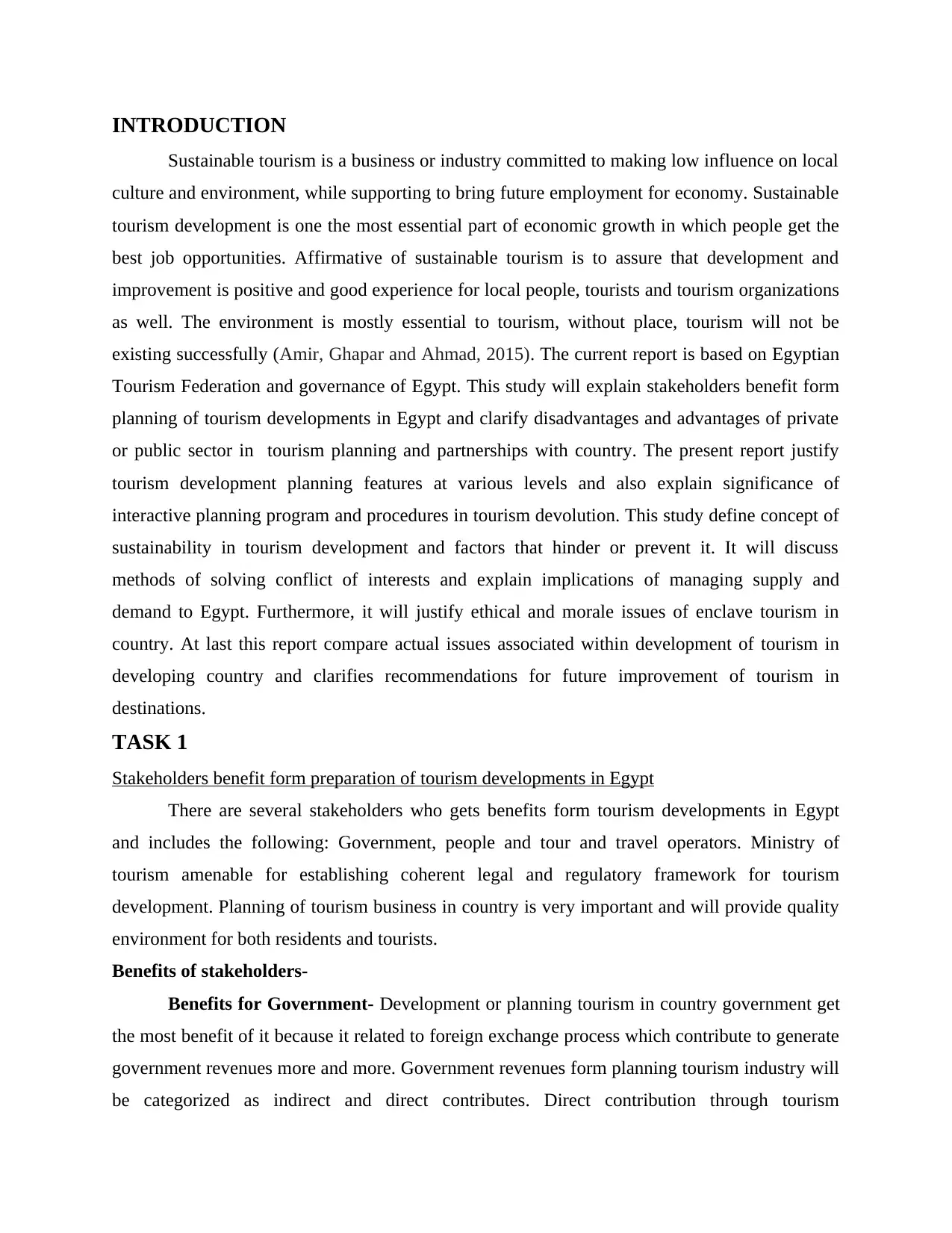
INTRODUCTION
Sustainable tourism is a business or industry committed to making low influence on local
culture and environment, while supporting to bring future employment for economy. Sustainable
tourism development is one the most essential part of economic growth in which people get the
best job opportunities. Affirmative of sustainable tourism is to assure that development and
improvement is positive and good experience for local people, tourists and tourism organizations
as well. The environment is mostly essential to tourism, without place, tourism will not be
existing successfully (Amir, Ghapar and Ahmad, 2015). The current report is based on Egyptian
Tourism Federation and governance of Egypt. This study will explain stakeholders benefit form
planning of tourism developments in Egypt and clarify disadvantages and advantages of private
or public sector in tourism planning and partnerships with country. The present report justify
tourism development planning features at various levels and also explain significance of
interactive planning program and procedures in tourism devolution. This study define concept of
sustainability in tourism development and factors that hinder or prevent it. It will discuss
methods of solving conflict of interests and explain implications of managing supply and
demand to Egypt. Furthermore, it will justify ethical and morale issues of enclave tourism in
country. At last this report compare actual issues associated within development of tourism in
developing country and clarifies recommendations for future improvement of tourism in
destinations.
TASK 1
Stakeholders benefit form preparation of tourism developments in Egypt
There are several stakeholders who gets benefits form tourism developments in Egypt
and includes the following: Government, people and tour and travel operators. Ministry of
tourism amenable for establishing coherent legal and regulatory framework for tourism
development. Planning of tourism business in country is very important and will provide quality
environment for both residents and tourists.
Benefits of stakeholders-
Benefits for Government- Development or planning tourism in country government get
the most benefit of it because it related to foreign exchange process which contribute to generate
government revenues more and more. Government revenues form planning tourism industry will
be categorized as indirect and direct contributes. Direct contribution through tourism
Sustainable tourism is a business or industry committed to making low influence on local
culture and environment, while supporting to bring future employment for economy. Sustainable
tourism development is one the most essential part of economic growth in which people get the
best job opportunities. Affirmative of sustainable tourism is to assure that development and
improvement is positive and good experience for local people, tourists and tourism organizations
as well. The environment is mostly essential to tourism, without place, tourism will not be
existing successfully (Amir, Ghapar and Ahmad, 2015). The current report is based on Egyptian
Tourism Federation and governance of Egypt. This study will explain stakeholders benefit form
planning of tourism developments in Egypt and clarify disadvantages and advantages of private
or public sector in tourism planning and partnerships with country. The present report justify
tourism development planning features at various levels and also explain significance of
interactive planning program and procedures in tourism devolution. This study define concept of
sustainability in tourism development and factors that hinder or prevent it. It will discuss
methods of solving conflict of interests and explain implications of managing supply and
demand to Egypt. Furthermore, it will justify ethical and morale issues of enclave tourism in
country. At last this report compare actual issues associated within development of tourism in
developing country and clarifies recommendations for future improvement of tourism in
destinations.
TASK 1
Stakeholders benefit form preparation of tourism developments in Egypt
There are several stakeholders who gets benefits form tourism developments in Egypt
and includes the following: Government, people and tour and travel operators. Ministry of
tourism amenable for establishing coherent legal and regulatory framework for tourism
development. Planning of tourism business in country is very important and will provide quality
environment for both residents and tourists.
Benefits of stakeholders-
Benefits for Government- Development or planning tourism in country government get
the most benefit of it because it related to foreign exchange process which contribute to generate
government revenues more and more. Government revenues form planning tourism industry will
be categorized as indirect and direct contributes. Direct contribution through tourism
⊘ This is a preview!⊘
Do you want full access?
Subscribe today to unlock all pages.

Trusted by 1+ million students worldwide
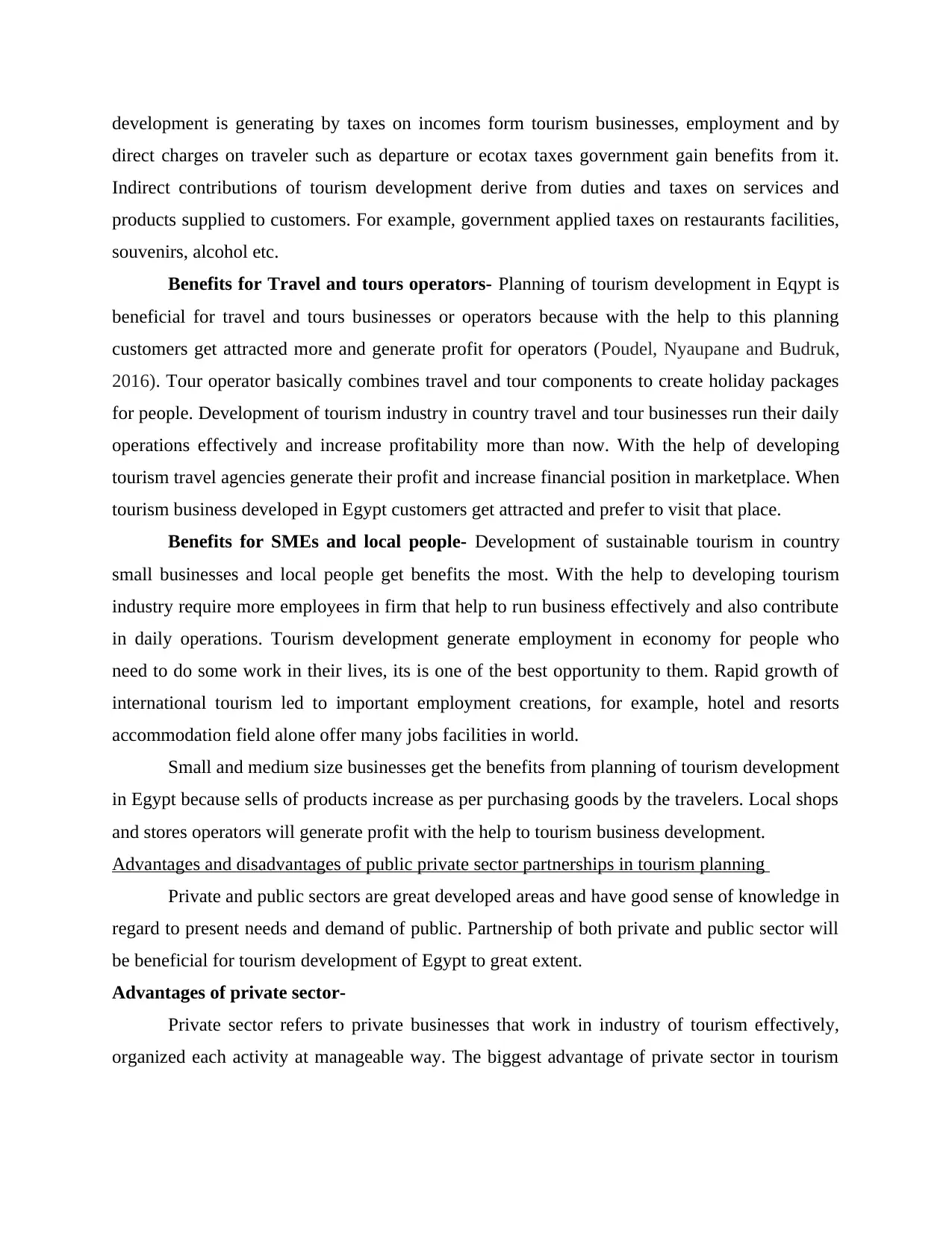
development is generating by taxes on incomes form tourism businesses, employment and by
direct charges on traveler such as departure or ecotax taxes government gain benefits from it.
Indirect contributions of tourism development derive from duties and taxes on services and
products supplied to customers. For example, government applied taxes on restaurants facilities,
souvenirs, alcohol etc.
Benefits for Travel and tours operators- Planning of tourism development in Eqypt is
beneficial for travel and tours businesses or operators because with the help to this planning
customers get attracted more and generate profit for operators (Poudel, Nyaupane and Budruk,
2016). Tour operator basically combines travel and tour components to create holiday packages
for people. Development of tourism industry in country travel and tour businesses run their daily
operations effectively and increase profitability more than now. With the help of developing
tourism travel agencies generate their profit and increase financial position in marketplace. When
tourism business developed in Egypt customers get attracted and prefer to visit that place.
Benefits for SMEs and local people- Development of sustainable tourism in country
small businesses and local people get benefits the most. With the help to developing tourism
industry require more employees in firm that help to run business effectively and also contribute
in daily operations. Tourism development generate employment in economy for people who
need to do some work in their lives, its is one of the best opportunity to them. Rapid growth of
international tourism led to important employment creations, for example, hotel and resorts
accommodation field alone offer many jobs facilities in world.
Small and medium size businesses get the benefits from planning of tourism development
in Egypt because sells of products increase as per purchasing goods by the travelers. Local shops
and stores operators will generate profit with the help to tourism business development.
Advantages and disadvantages of public private sector partnerships in tourism planning
Private and public sectors are great developed areas and have good sense of knowledge in
regard to present needs and demand of public. Partnership of both private and public sector will
be beneficial for tourism development of Egypt to great extent.
Advantages of private sector-
Private sector refers to private businesses that work in industry of tourism effectively,
organized each activity at manageable way. The biggest advantage of private sector in tourism
direct charges on traveler such as departure or ecotax taxes government gain benefits from it.
Indirect contributions of tourism development derive from duties and taxes on services and
products supplied to customers. For example, government applied taxes on restaurants facilities,
souvenirs, alcohol etc.
Benefits for Travel and tours operators- Planning of tourism development in Eqypt is
beneficial for travel and tours businesses or operators because with the help to this planning
customers get attracted more and generate profit for operators (Poudel, Nyaupane and Budruk,
2016). Tour operator basically combines travel and tour components to create holiday packages
for people. Development of tourism industry in country travel and tour businesses run their daily
operations effectively and increase profitability more than now. With the help of developing
tourism travel agencies generate their profit and increase financial position in marketplace. When
tourism business developed in Egypt customers get attracted and prefer to visit that place.
Benefits for SMEs and local people- Development of sustainable tourism in country
small businesses and local people get benefits the most. With the help to developing tourism
industry require more employees in firm that help to run business effectively and also contribute
in daily operations. Tourism development generate employment in economy for people who
need to do some work in their lives, its is one of the best opportunity to them. Rapid growth of
international tourism led to important employment creations, for example, hotel and resorts
accommodation field alone offer many jobs facilities in world.
Small and medium size businesses get the benefits from planning of tourism development
in Egypt because sells of products increase as per purchasing goods by the travelers. Local shops
and stores operators will generate profit with the help to tourism business development.
Advantages and disadvantages of public private sector partnerships in tourism planning
Private and public sectors are great developed areas and have good sense of knowledge in
regard to present needs and demand of public. Partnership of both private and public sector will
be beneficial for tourism development of Egypt to great extent.
Advantages of private sector-
Private sector refers to private businesses that work in industry of tourism effectively,
organized each activity at manageable way. The biggest advantage of private sector in tourism
Paraphrase This Document
Need a fresh take? Get an instant paraphrase of this document with our AI Paraphraser
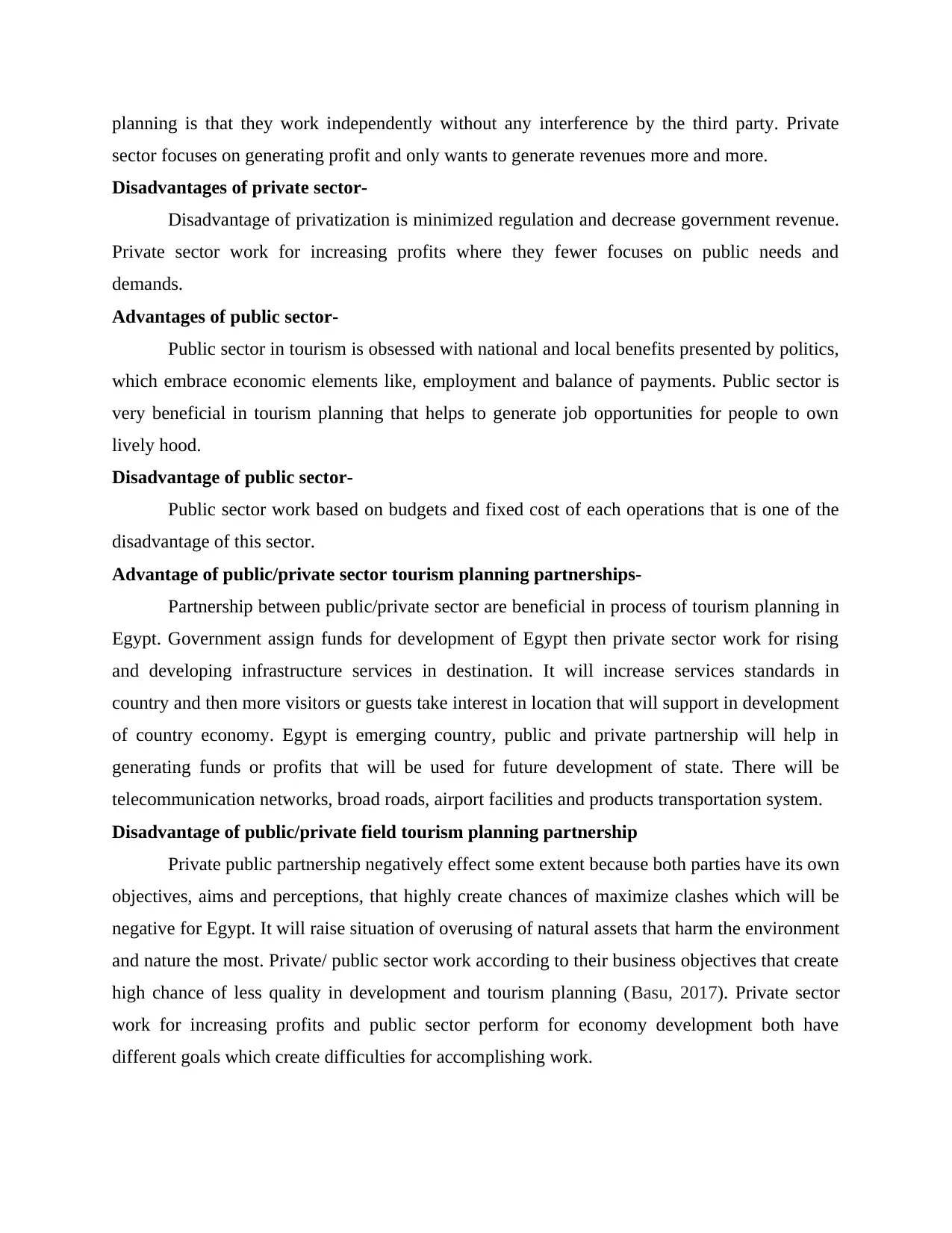
planning is that they work independently without any interference by the third party. Private
sector focuses on generating profit and only wants to generate revenues more and more.
Disadvantages of private sector-
Disadvantage of privatization is minimized regulation and decrease government revenue.
Private sector work for increasing profits where they fewer focuses on public needs and
demands.
Advantages of public sector-
Public sector in tourism is obsessed with national and local benefits presented by politics,
which embrace economic elements like, employment and balance of payments. Public sector is
very beneficial in tourism planning that helps to generate job opportunities for people to own
lively hood.
Disadvantage of public sector-
Public sector work based on budgets and fixed cost of each operations that is one of the
disadvantage of this sector.
Advantage of public/private sector tourism planning partnerships-
Partnership between public/private sector are beneficial in process of tourism planning in
Egypt. Government assign funds for development of Egypt then private sector work for rising
and developing infrastructure services in destination. It will increase services standards in
country and then more visitors or guests take interest in location that will support in development
of country economy. Egypt is emerging country, public and private partnership will help in
generating funds or profits that will be used for future development of state. There will be
telecommunication networks, broad roads, airport facilities and products transportation system.
Disadvantage of public/private field tourism planning partnership
Private public partnership negatively effect some extent because both parties have its own
objectives, aims and perceptions, that highly create chances of maximize clashes which will be
negative for Egypt. It will raise situation of overusing of natural assets that harm the environment
and nature the most. Private/ public sector work according to their business objectives that create
high chance of less quality in development and tourism planning (Basu, 2017). Private sector
work for increasing profits and public sector perform for economy development both have
different goals which create difficulties for accomplishing work.
sector focuses on generating profit and only wants to generate revenues more and more.
Disadvantages of private sector-
Disadvantage of privatization is minimized regulation and decrease government revenue.
Private sector work for increasing profits where they fewer focuses on public needs and
demands.
Advantages of public sector-
Public sector in tourism is obsessed with national and local benefits presented by politics,
which embrace economic elements like, employment and balance of payments. Public sector is
very beneficial in tourism planning that helps to generate job opportunities for people to own
lively hood.
Disadvantage of public sector-
Public sector work based on budgets and fixed cost of each operations that is one of the
disadvantage of this sector.
Advantage of public/private sector tourism planning partnerships-
Partnership between public/private sector are beneficial in process of tourism planning in
Egypt. Government assign funds for development of Egypt then private sector work for rising
and developing infrastructure services in destination. It will increase services standards in
country and then more visitors or guests take interest in location that will support in development
of country economy. Egypt is emerging country, public and private partnership will help in
generating funds or profits that will be used for future development of state. There will be
telecommunication networks, broad roads, airport facilities and products transportation system.
Disadvantage of public/private field tourism planning partnership
Private public partnership negatively effect some extent because both parties have its own
objectives, aims and perceptions, that highly create chances of maximize clashes which will be
negative for Egypt. It will raise situation of overusing of natural assets that harm the environment
and nature the most. Private/ public sector work according to their business objectives that create
high chance of less quality in development and tourism planning (Basu, 2017). Private sector
work for increasing profits and public sector perform for economy development both have
different goals which create difficulties for accomplishing work.
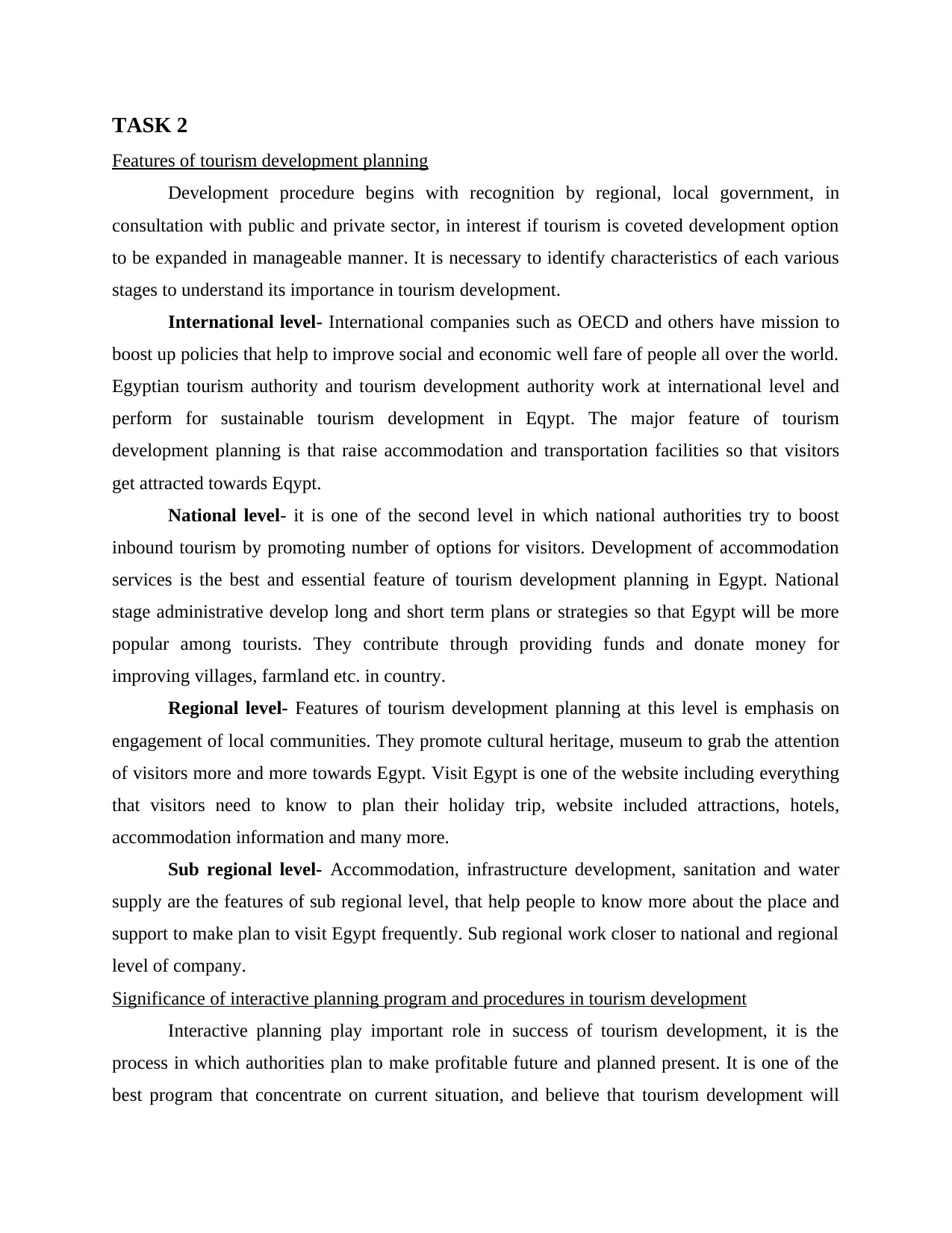
TASK 2
Features of tourism development planning
Development procedure begins with recognition by regional, local government, in
consultation with public and private sector, in interest if tourism is coveted development option
to be expanded in manageable manner. It is necessary to identify characteristics of each various
stages to understand its importance in tourism development.
International level- International companies such as OECD and others have mission to
boost up policies that help to improve social and economic well fare of people all over the world.
Egyptian tourism authority and tourism development authority work at international level and
perform for sustainable tourism development in Eqypt. The major feature of tourism
development planning is that raise accommodation and transportation facilities so that visitors
get attracted towards Eqypt.
National level- it is one of the second level in which national authorities try to boost
inbound tourism by promoting number of options for visitors. Development of accommodation
services is the best and essential feature of tourism development planning in Egypt. National
stage administrative develop long and short term plans or strategies so that Egypt will be more
popular among tourists. They contribute through providing funds and donate money for
improving villages, farmland etc. in country.
Regional level- Features of tourism development planning at this level is emphasis on
engagement of local communities. They promote cultural heritage, museum to grab the attention
of visitors more and more towards Egypt. Visit Egypt is one of the website including everything
that visitors need to know to plan their holiday trip, website included attractions, hotels,
accommodation information and many more.
Sub regional level- Accommodation, infrastructure development, sanitation and water
supply are the features of sub regional level, that help people to know more about the place and
support to make plan to visit Egypt frequently. Sub regional work closer to national and regional
level of company.
Significance of interactive planning program and procedures in tourism development
Interactive planning play important role in success of tourism development, it is the
process in which authorities plan to make profitable future and planned present. It is one of the
best program that concentrate on current situation, and believe that tourism development will
Features of tourism development planning
Development procedure begins with recognition by regional, local government, in
consultation with public and private sector, in interest if tourism is coveted development option
to be expanded in manageable manner. It is necessary to identify characteristics of each various
stages to understand its importance in tourism development.
International level- International companies such as OECD and others have mission to
boost up policies that help to improve social and economic well fare of people all over the world.
Egyptian tourism authority and tourism development authority work at international level and
perform for sustainable tourism development in Eqypt. The major feature of tourism
development planning is that raise accommodation and transportation facilities so that visitors
get attracted towards Eqypt.
National level- it is one of the second level in which national authorities try to boost
inbound tourism by promoting number of options for visitors. Development of accommodation
services is the best and essential feature of tourism development planning in Egypt. National
stage administrative develop long and short term plans or strategies so that Egypt will be more
popular among tourists. They contribute through providing funds and donate money for
improving villages, farmland etc. in country.
Regional level- Features of tourism development planning at this level is emphasis on
engagement of local communities. They promote cultural heritage, museum to grab the attention
of visitors more and more towards Egypt. Visit Egypt is one of the website including everything
that visitors need to know to plan their holiday trip, website included attractions, hotels,
accommodation information and many more.
Sub regional level- Accommodation, infrastructure development, sanitation and water
supply are the features of sub regional level, that help people to know more about the place and
support to make plan to visit Egypt frequently. Sub regional work closer to national and regional
level of company.
Significance of interactive planning program and procedures in tourism development
Interactive planning play important role in success of tourism development, it is the
process in which authorities plan to make profitable future and planned present. It is one of the
best program that concentrate on current situation, and believe that tourism development will
⊘ This is a preview!⊘
Do you want full access?
Subscribe today to unlock all pages.

Trusted by 1+ million students worldwide
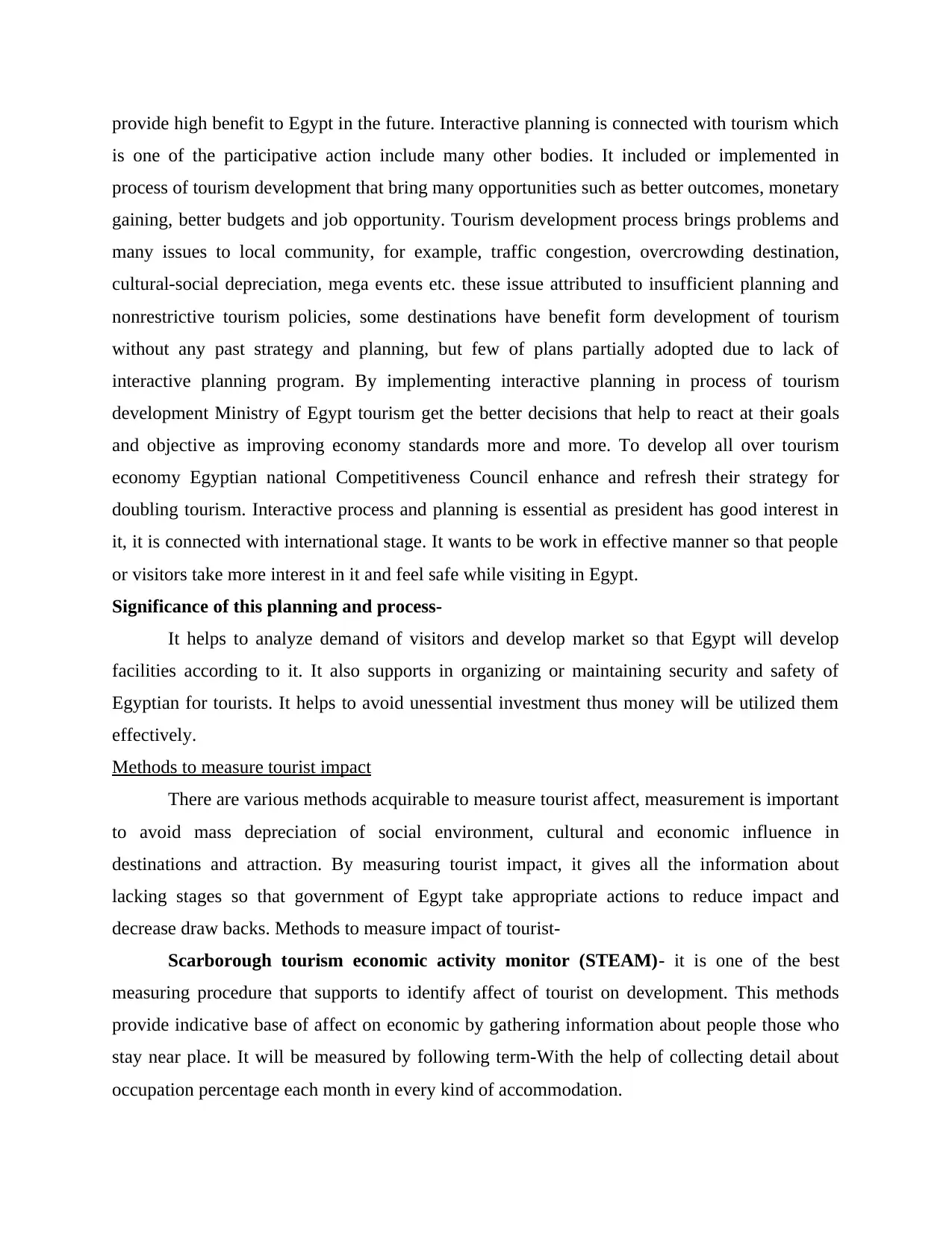
provide high benefit to Egypt in the future. Interactive planning is connected with tourism which
is one of the participative action include many other bodies. It included or implemented in
process of tourism development that bring many opportunities such as better outcomes, monetary
gaining, better budgets and job opportunity. Tourism development process brings problems and
many issues to local community, for example, traffic congestion, overcrowding destination,
cultural-social depreciation, mega events etc. these issue attributed to insufficient planning and
nonrestrictive tourism policies, some destinations have benefit form development of tourism
without any past strategy and planning, but few of plans partially adopted due to lack of
interactive planning program. By implementing interactive planning in process of tourism
development Ministry of Egypt tourism get the better decisions that help to react at their goals
and objective as improving economy standards more and more. To develop all over tourism
economy Egyptian national Competitiveness Council enhance and refresh their strategy for
doubling tourism. Interactive process and planning is essential as president has good interest in
it, it is connected with international stage. It wants to be work in effective manner so that people
or visitors take more interest in it and feel safe while visiting in Egypt.
Significance of this planning and process-
It helps to analyze demand of visitors and develop market so that Egypt will develop
facilities according to it. It also supports in organizing or maintaining security and safety of
Egyptian for tourists. It helps to avoid unessential investment thus money will be utilized them
effectively.
Methods to measure tourist impact
There are various methods acquirable to measure tourist affect, measurement is important
to avoid mass depreciation of social environment, cultural and economic influence in
destinations and attraction. By measuring tourist impact, it gives all the information about
lacking stages so that government of Egypt take appropriate actions to reduce impact and
decrease draw backs. Methods to measure impact of tourist-
Scarborough tourism economic activity monitor (STEAM)- it is one of the best
measuring procedure that supports to identify affect of tourist on development. This methods
provide indicative base of affect on economic by gathering information about people those who
stay near place. It will be measured by following term-With the help of collecting detail about
occupation percentage each month in every kind of accommodation.
is one of the participative action include many other bodies. It included or implemented in
process of tourism development that bring many opportunities such as better outcomes, monetary
gaining, better budgets and job opportunity. Tourism development process brings problems and
many issues to local community, for example, traffic congestion, overcrowding destination,
cultural-social depreciation, mega events etc. these issue attributed to insufficient planning and
nonrestrictive tourism policies, some destinations have benefit form development of tourism
without any past strategy and planning, but few of plans partially adopted due to lack of
interactive planning program. By implementing interactive planning in process of tourism
development Ministry of Egypt tourism get the better decisions that help to react at their goals
and objective as improving economy standards more and more. To develop all over tourism
economy Egyptian national Competitiveness Council enhance and refresh their strategy for
doubling tourism. Interactive process and planning is essential as president has good interest in
it, it is connected with international stage. It wants to be work in effective manner so that people
or visitors take more interest in it and feel safe while visiting in Egypt.
Significance of this planning and process-
It helps to analyze demand of visitors and develop market so that Egypt will develop
facilities according to it. It also supports in organizing or maintaining security and safety of
Egyptian for tourists. It helps to avoid unessential investment thus money will be utilized them
effectively.
Methods to measure tourist impact
There are various methods acquirable to measure tourist affect, measurement is important
to avoid mass depreciation of social environment, cultural and economic influence in
destinations and attraction. By measuring tourist impact, it gives all the information about
lacking stages so that government of Egypt take appropriate actions to reduce impact and
decrease draw backs. Methods to measure impact of tourist-
Scarborough tourism economic activity monitor (STEAM)- it is one of the best
measuring procedure that supports to identify affect of tourist on development. This methods
provide indicative base of affect on economic by gathering information about people those who
stay near place. It will be measured by following term-With the help of collecting detail about
occupation percentage each month in every kind of accommodation.
Paraphrase This Document
Need a fresh take? Get an instant paraphrase of this document with our AI Paraphraser
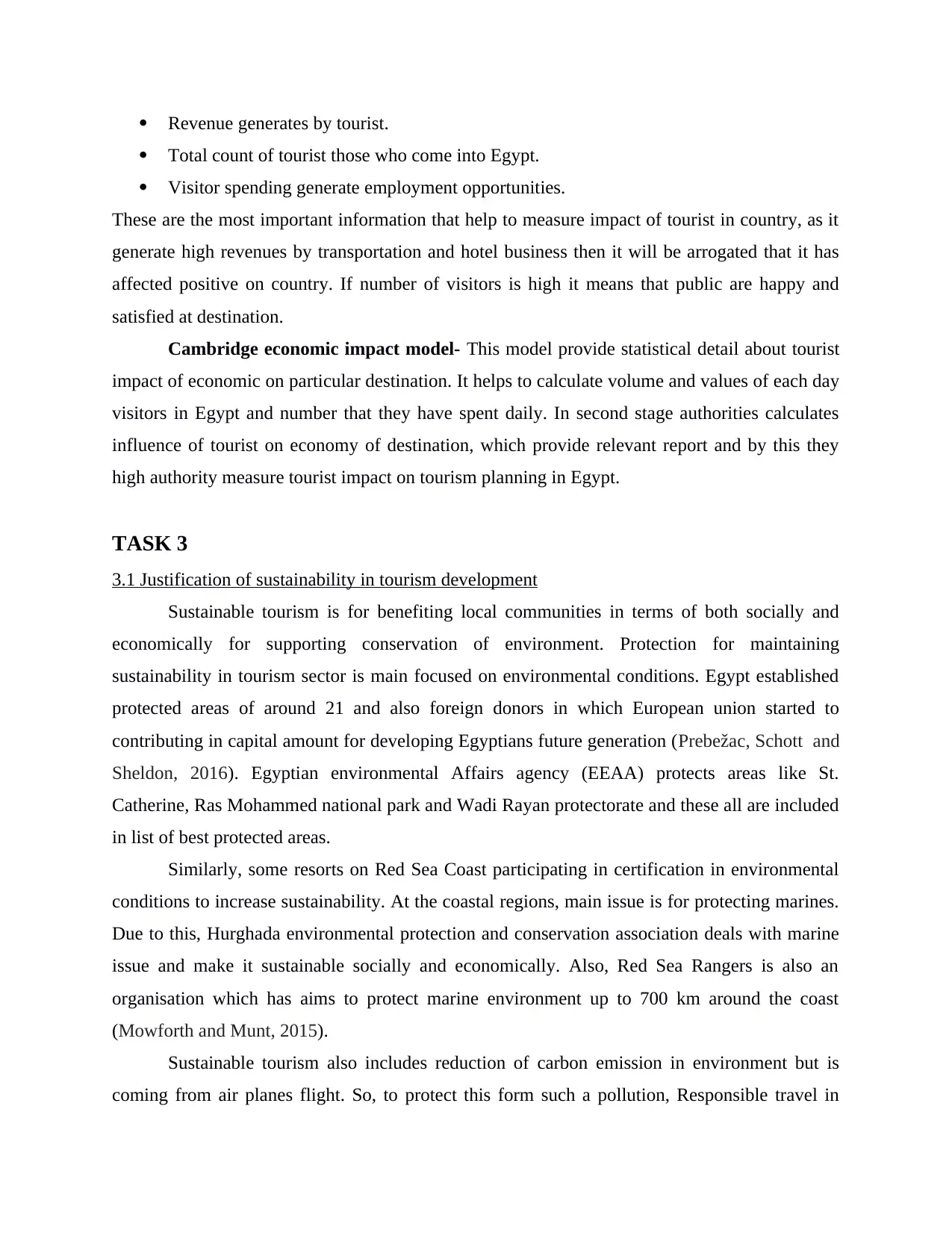
Revenue generates by tourist.
Total count of tourist those who come into Egypt.
Visitor spending generate employment opportunities.
These are the most important information that help to measure impact of tourist in country, as it
generate high revenues by transportation and hotel business then it will be arrogated that it has
affected positive on country. If number of visitors is high it means that public are happy and
satisfied at destination.
Cambridge economic impact model- This model provide statistical detail about tourist
impact of economic on particular destination. It helps to calculate volume and values of each day
visitors in Egypt and number that they have spent daily. In second stage authorities calculates
influence of tourist on economy of destination, which provide relevant report and by this they
high authority measure tourist impact on tourism planning in Egypt.
TASK 3
3.1 Justification of sustainability in tourism development
Sustainable tourism is for benefiting local communities in terms of both socially and
economically for supporting conservation of environment. Protection for maintaining
sustainability in tourism sector is main focused on environmental conditions. Egypt established
protected areas of around 21 and also foreign donors in which European union started to
contributing in capital amount for developing Egyptians future generation (Prebežac, Schott and
Sheldon, 2016). Egyptian environmental Affairs agency (EEAA) protects areas like St.
Catherine, Ras Mohammed national park and Wadi Rayan protectorate and these all are included
in list of best protected areas.
Similarly, some resorts on Red Sea Coast participating in certification in environmental
conditions to increase sustainability. At the coastal regions, main issue is for protecting marines.
Due to this, Hurghada environmental protection and conservation association deals with marine
issue and make it sustainable socially and economically. Also, Red Sea Rangers is also an
organisation which has aims to protect marine environment up to 700 km around the coast
(Mowforth and Munt, 2015).
Sustainable tourism also includes reduction of carbon emission in environment but is
coming from air planes flight. So, to protect this form such a pollution, Responsible travel in
Total count of tourist those who come into Egypt.
Visitor spending generate employment opportunities.
These are the most important information that help to measure impact of tourist in country, as it
generate high revenues by transportation and hotel business then it will be arrogated that it has
affected positive on country. If number of visitors is high it means that public are happy and
satisfied at destination.
Cambridge economic impact model- This model provide statistical detail about tourist
impact of economic on particular destination. It helps to calculate volume and values of each day
visitors in Egypt and number that they have spent daily. In second stage authorities calculates
influence of tourist on economy of destination, which provide relevant report and by this they
high authority measure tourist impact on tourism planning in Egypt.
TASK 3
3.1 Justification of sustainability in tourism development
Sustainable tourism is for benefiting local communities in terms of both socially and
economically for supporting conservation of environment. Protection for maintaining
sustainability in tourism sector is main focused on environmental conditions. Egypt established
protected areas of around 21 and also foreign donors in which European union started to
contributing in capital amount for developing Egyptians future generation (Prebežac, Schott and
Sheldon, 2016). Egyptian environmental Affairs agency (EEAA) protects areas like St.
Catherine, Ras Mohammed national park and Wadi Rayan protectorate and these all are included
in list of best protected areas.
Similarly, some resorts on Red Sea Coast participating in certification in environmental
conditions to increase sustainability. At the coastal regions, main issue is for protecting marines.
Due to this, Hurghada environmental protection and conservation association deals with marine
issue and make it sustainable socially and economically. Also, Red Sea Rangers is also an
organisation which has aims to protect marine environment up to 700 km around the coast
(Mowforth and Munt, 2015).
Sustainable tourism also includes reduction of carbon emission in environment but is
coming from air planes flight. So, to protect this form such a pollution, Responsible travel in
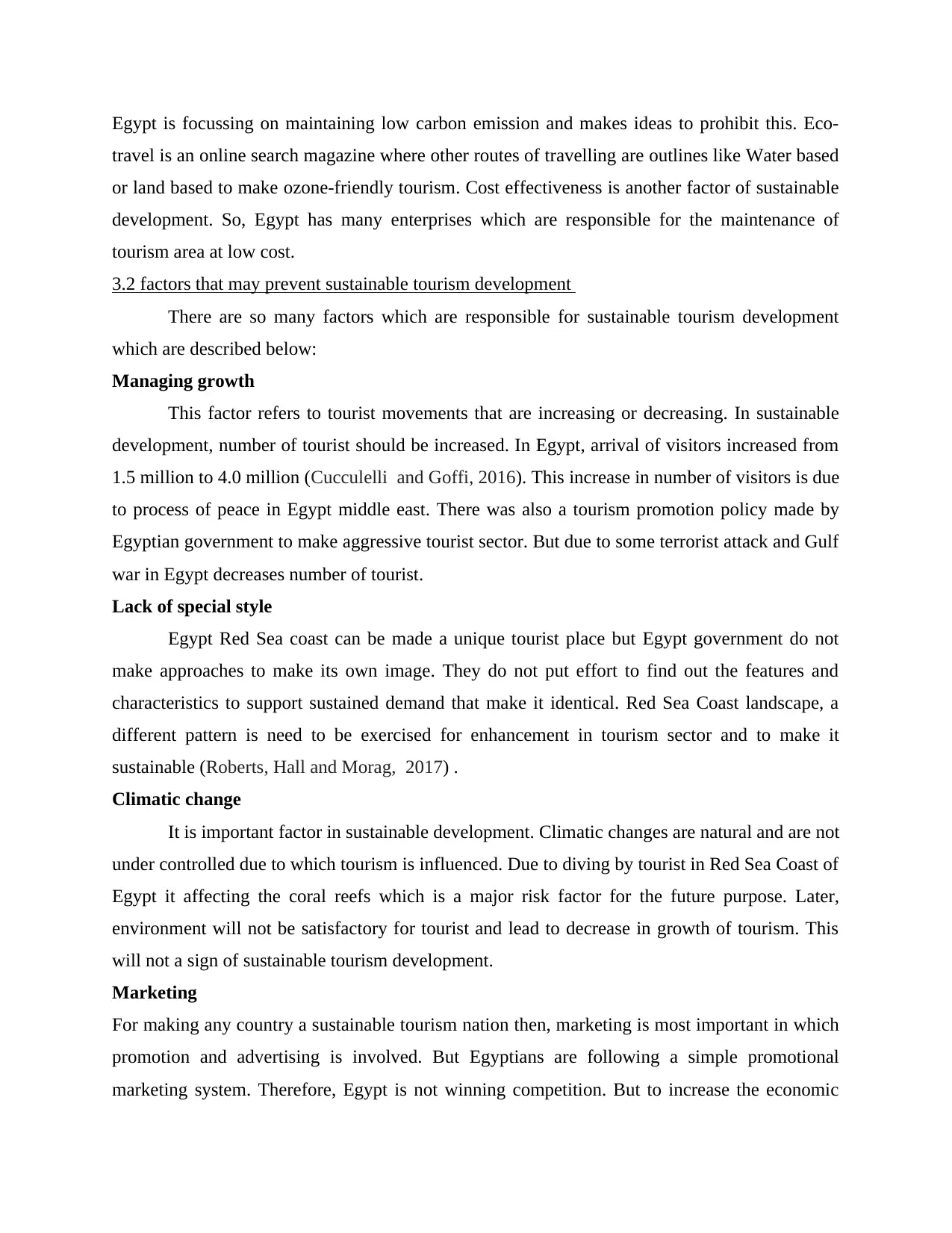
Egypt is focussing on maintaining low carbon emission and makes ideas to prohibit this. Eco-
travel is an online search magazine where other routes of travelling are outlines like Water based
or land based to make ozone-friendly tourism. Cost effectiveness is another factor of sustainable
development. So, Egypt has many enterprises which are responsible for the maintenance of
tourism area at low cost.
3.2 factors that may prevent sustainable tourism development
There are so many factors which are responsible for sustainable tourism development
which are described below:
Managing growth
This factor refers to tourist movements that are increasing or decreasing. In sustainable
development, number of tourist should be increased. In Egypt, arrival of visitors increased from
1.5 million to 4.0 million (Cucculelli and Goffi, 2016). This increase in number of visitors is due
to process of peace in Egypt middle east. There was also a tourism promotion policy made by
Egyptian government to make aggressive tourist sector. But due to some terrorist attack and Gulf
war in Egypt decreases number of tourist.
Lack of special style
Egypt Red Sea coast can be made a unique tourist place but Egypt government do not
make approaches to make its own image. They do not put effort to find out the features and
characteristics to support sustained demand that make it identical. Red Sea Coast landscape, a
different pattern is need to be exercised for enhancement in tourism sector and to make it
sustainable (Roberts, Hall and Morag, 2017) .
Climatic change
It is important factor in sustainable development. Climatic changes are natural and are not
under controlled due to which tourism is influenced. Due to diving by tourist in Red Sea Coast of
Egypt it affecting the coral reefs which is a major risk factor for the future purpose. Later,
environment will not be satisfactory for tourist and lead to decrease in growth of tourism. This
will not a sign of sustainable tourism development.
Marketing
For making any country a sustainable tourism nation then, marketing is most important in which
promotion and advertising is involved. But Egyptians are following a simple promotional
marketing system. Therefore, Egypt is not winning competition. But to increase the economic
travel is an online search magazine where other routes of travelling are outlines like Water based
or land based to make ozone-friendly tourism. Cost effectiveness is another factor of sustainable
development. So, Egypt has many enterprises which are responsible for the maintenance of
tourism area at low cost.
3.2 factors that may prevent sustainable tourism development
There are so many factors which are responsible for sustainable tourism development
which are described below:
Managing growth
This factor refers to tourist movements that are increasing or decreasing. In sustainable
development, number of tourist should be increased. In Egypt, arrival of visitors increased from
1.5 million to 4.0 million (Cucculelli and Goffi, 2016). This increase in number of visitors is due
to process of peace in Egypt middle east. There was also a tourism promotion policy made by
Egyptian government to make aggressive tourist sector. But due to some terrorist attack and Gulf
war in Egypt decreases number of tourist.
Lack of special style
Egypt Red Sea coast can be made a unique tourist place but Egypt government do not
make approaches to make its own image. They do not put effort to find out the features and
characteristics to support sustained demand that make it identical. Red Sea Coast landscape, a
different pattern is need to be exercised for enhancement in tourism sector and to make it
sustainable (Roberts, Hall and Morag, 2017) .
Climatic change
It is important factor in sustainable development. Climatic changes are natural and are not
under controlled due to which tourism is influenced. Due to diving by tourist in Red Sea Coast of
Egypt it affecting the coral reefs which is a major risk factor for the future purpose. Later,
environment will not be satisfactory for tourist and lead to decrease in growth of tourism. This
will not a sign of sustainable tourism development.
Marketing
For making any country a sustainable tourism nation then, marketing is most important in which
promotion and advertising is involved. But Egyptians are following a simple promotional
marketing system. Therefore, Egypt is not winning competition. But to increase the economic
⊘ This is a preview!⊘
Do you want full access?
Subscribe today to unlock all pages.

Trusted by 1+ million students worldwide
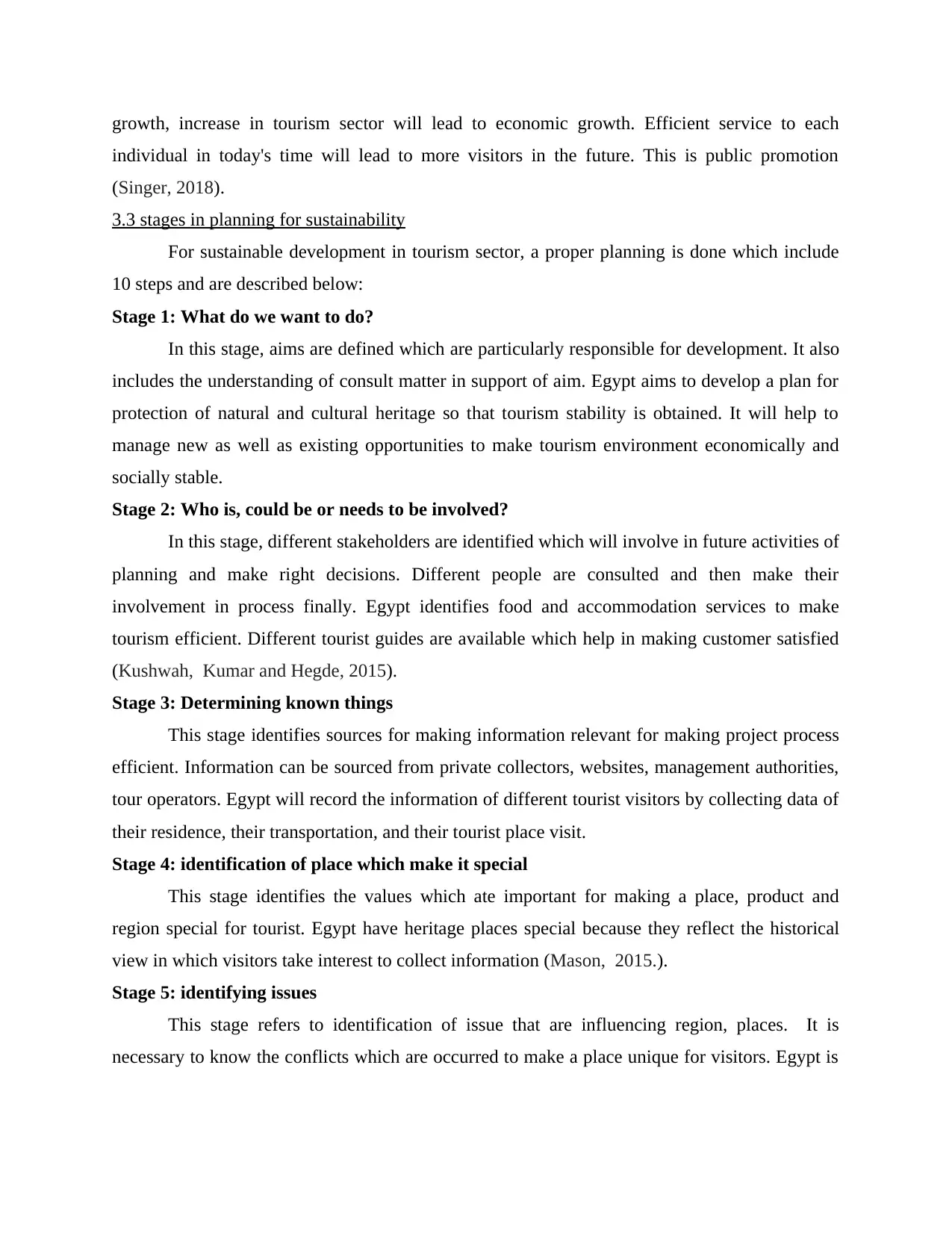
growth, increase in tourism sector will lead to economic growth. Efficient service to each
individual in today's time will lead to more visitors in the future. This is public promotion
(Singer, 2018).
3.3 stages in planning for sustainability
For sustainable development in tourism sector, a proper planning is done which include
10 steps and are described below:
Stage 1: What do we want to do?
In this stage, aims are defined which are particularly responsible for development. It also
includes the understanding of consult matter in support of aim. Egypt aims to develop a plan for
protection of natural and cultural heritage so that tourism stability is obtained. It will help to
manage new as well as existing opportunities to make tourism environment economically and
socially stable.
Stage 2: Who is, could be or needs to be involved?
In this stage, different stakeholders are identified which will involve in future activities of
planning and make right decisions. Different people are consulted and then make their
involvement in process finally. Egypt identifies food and accommodation services to make
tourism efficient. Different tourist guides are available which help in making customer satisfied
(Kushwah, Kumar and Hegde, 2015).
Stage 3: Determining known things
This stage identifies sources for making information relevant for making project process
efficient. Information can be sourced from private collectors, websites, management authorities,
tour operators. Egypt will record the information of different tourist visitors by collecting data of
their residence, their transportation, and their tourist place visit.
Stage 4: identification of place which make it special
This stage identifies the values which ate important for making a place, product and
region special for tourist. Egypt have heritage places special because they reflect the historical
view in which visitors take interest to collect information (Mason, 2015.).
Stage 5: identifying issues
This stage refers to identification of issue that are influencing region, places. It is
necessary to know the conflicts which are occurred to make a place unique for visitors. Egypt is
individual in today's time will lead to more visitors in the future. This is public promotion
(Singer, 2018).
3.3 stages in planning for sustainability
For sustainable development in tourism sector, a proper planning is done which include
10 steps and are described below:
Stage 1: What do we want to do?
In this stage, aims are defined which are particularly responsible for development. It also
includes the understanding of consult matter in support of aim. Egypt aims to develop a plan for
protection of natural and cultural heritage so that tourism stability is obtained. It will help to
manage new as well as existing opportunities to make tourism environment economically and
socially stable.
Stage 2: Who is, could be or needs to be involved?
In this stage, different stakeholders are identified which will involve in future activities of
planning and make right decisions. Different people are consulted and then make their
involvement in process finally. Egypt identifies food and accommodation services to make
tourism efficient. Different tourist guides are available which help in making customer satisfied
(Kushwah, Kumar and Hegde, 2015).
Stage 3: Determining known things
This stage identifies sources for making information relevant for making project process
efficient. Information can be sourced from private collectors, websites, management authorities,
tour operators. Egypt will record the information of different tourist visitors by collecting data of
their residence, their transportation, and their tourist place visit.
Stage 4: identification of place which make it special
This stage identifies the values which ate important for making a place, product and
region special for tourist. Egypt have heritage places special because they reflect the historical
view in which visitors take interest to collect information (Mason, 2015.).
Stage 5: identifying issues
This stage refers to identification of issue that are influencing region, places. It is
necessary to know the conflicts which are occurred to make a place unique for visitors. Egypt is
Paraphrase This Document
Need a fresh take? Get an instant paraphrase of this document with our AI Paraphraser
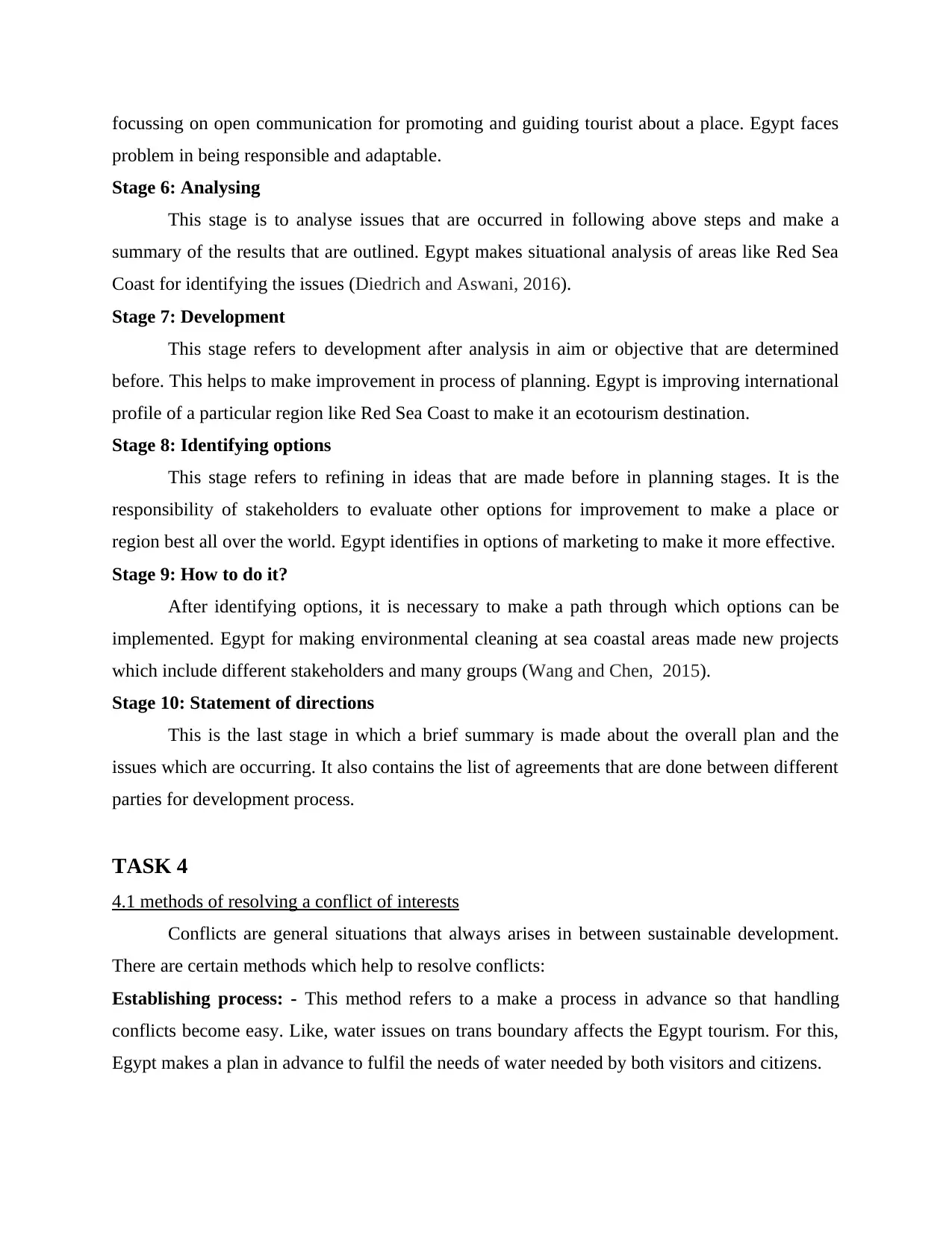
focussing on open communication for promoting and guiding tourist about a place. Egypt faces
problem in being responsible and adaptable.
Stage 6: Analysing
This stage is to analyse issues that are occurred in following above steps and make a
summary of the results that are outlined. Egypt makes situational analysis of areas like Red Sea
Coast for identifying the issues (Diedrich and Aswani, 2016).
Stage 7: Development
This stage refers to development after analysis in aim or objective that are determined
before. This helps to make improvement in process of planning. Egypt is improving international
profile of a particular region like Red Sea Coast to make it an ecotourism destination.
Stage 8: Identifying options
This stage refers to refining in ideas that are made before in planning stages. It is the
responsibility of stakeholders to evaluate other options for improvement to make a place or
region best all over the world. Egypt identifies in options of marketing to make it more effective.
Stage 9: How to do it?
After identifying options, it is necessary to make a path through which options can be
implemented. Egypt for making environmental cleaning at sea coastal areas made new projects
which include different stakeholders and many groups (Wang and Chen, 2015).
Stage 10: Statement of directions
This is the last stage in which a brief summary is made about the overall plan and the
issues which are occurring. It also contains the list of agreements that are done between different
parties for development process.
TASK 4
4.1 methods of resolving a conflict of interests
Conflicts are general situations that always arises in between sustainable development.
There are certain methods which help to resolve conflicts:
Establishing process: - This method refers to a make a process in advance so that handling
conflicts become easy. Like, water issues on trans boundary affects the Egypt tourism. For this,
Egypt makes a plan in advance to fulfil the needs of water needed by both visitors and citizens.
problem in being responsible and adaptable.
Stage 6: Analysing
This stage is to analyse issues that are occurred in following above steps and make a
summary of the results that are outlined. Egypt makes situational analysis of areas like Red Sea
Coast for identifying the issues (Diedrich and Aswani, 2016).
Stage 7: Development
This stage refers to development after analysis in aim or objective that are determined
before. This helps to make improvement in process of planning. Egypt is improving international
profile of a particular region like Red Sea Coast to make it an ecotourism destination.
Stage 8: Identifying options
This stage refers to refining in ideas that are made before in planning stages. It is the
responsibility of stakeholders to evaluate other options for improvement to make a place or
region best all over the world. Egypt identifies in options of marketing to make it more effective.
Stage 9: How to do it?
After identifying options, it is necessary to make a path through which options can be
implemented. Egypt for making environmental cleaning at sea coastal areas made new projects
which include different stakeholders and many groups (Wang and Chen, 2015).
Stage 10: Statement of directions
This is the last stage in which a brief summary is made about the overall plan and the
issues which are occurring. It also contains the list of agreements that are done between different
parties for development process.
TASK 4
4.1 methods of resolving a conflict of interests
Conflicts are general situations that always arises in between sustainable development.
There are certain methods which help to resolve conflicts:
Establishing process: - This method refers to a make a process in advance so that handling
conflicts become easy. Like, water issues on trans boundary affects the Egypt tourism. For this,
Egypt makes a plan in advance to fulfil the needs of water needed by both visitors and citizens.
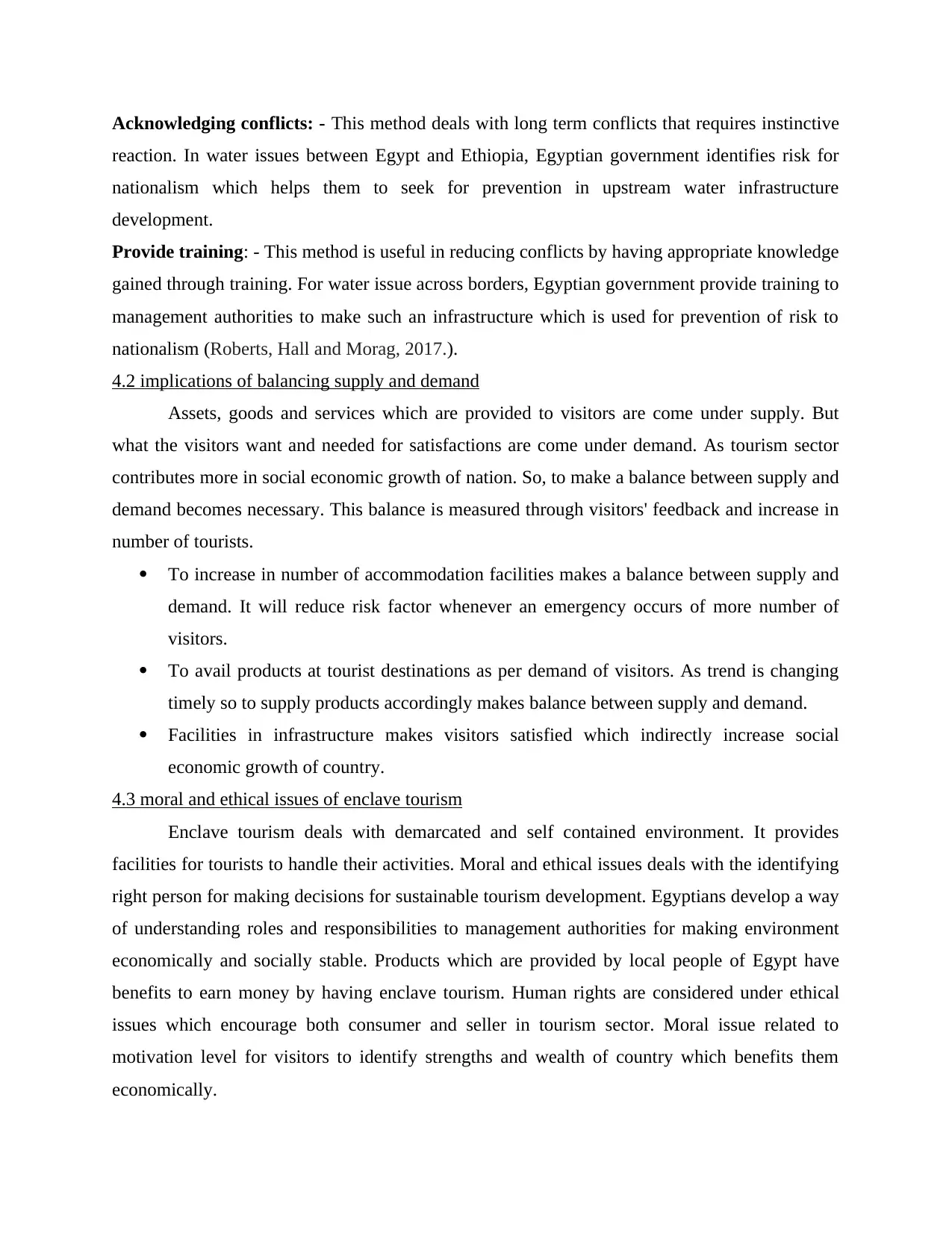
Acknowledging conflicts: - This method deals with long term conflicts that requires instinctive
reaction. In water issues between Egypt and Ethiopia, Egyptian government identifies risk for
nationalism which helps them to seek for prevention in upstream water infrastructure
development.
Provide training: - This method is useful in reducing conflicts by having appropriate knowledge
gained through training. For water issue across borders, Egyptian government provide training to
management authorities to make such an infrastructure which is used for prevention of risk to
nationalism (Roberts, Hall and Morag, 2017.).
4.2 implications of balancing supply and demand
Assets, goods and services which are provided to visitors are come under supply. But
what the visitors want and needed for satisfactions are come under demand. As tourism sector
contributes more in social economic growth of nation. So, to make a balance between supply and
demand becomes necessary. This balance is measured through visitors' feedback and increase in
number of tourists.
To increase in number of accommodation facilities makes a balance between supply and
demand. It will reduce risk factor whenever an emergency occurs of more number of
visitors.
To avail products at tourist destinations as per demand of visitors. As trend is changing
timely so to supply products accordingly makes balance between supply and demand.
Facilities in infrastructure makes visitors satisfied which indirectly increase social
economic growth of country.
4.3 moral and ethical issues of enclave tourism
Enclave tourism deals with demarcated and self contained environment. It provides
facilities for tourists to handle their activities. Moral and ethical issues deals with the identifying
right person for making decisions for sustainable tourism development. Egyptians develop a way
of understanding roles and responsibilities to management authorities for making environment
economically and socially stable. Products which are provided by local people of Egypt have
benefits to earn money by having enclave tourism. Human rights are considered under ethical
issues which encourage both consumer and seller in tourism sector. Moral issue related to
motivation level for visitors to identify strengths and wealth of country which benefits them
economically.
reaction. In water issues between Egypt and Ethiopia, Egyptian government identifies risk for
nationalism which helps them to seek for prevention in upstream water infrastructure
development.
Provide training: - This method is useful in reducing conflicts by having appropriate knowledge
gained through training. For water issue across borders, Egyptian government provide training to
management authorities to make such an infrastructure which is used for prevention of risk to
nationalism (Roberts, Hall and Morag, 2017.).
4.2 implications of balancing supply and demand
Assets, goods and services which are provided to visitors are come under supply. But
what the visitors want and needed for satisfactions are come under demand. As tourism sector
contributes more in social economic growth of nation. So, to make a balance between supply and
demand becomes necessary. This balance is measured through visitors' feedback and increase in
number of tourists.
To increase in number of accommodation facilities makes a balance between supply and
demand. It will reduce risk factor whenever an emergency occurs of more number of
visitors.
To avail products at tourist destinations as per demand of visitors. As trend is changing
timely so to supply products accordingly makes balance between supply and demand.
Facilities in infrastructure makes visitors satisfied which indirectly increase social
economic growth of country.
4.3 moral and ethical issues of enclave tourism
Enclave tourism deals with demarcated and self contained environment. It provides
facilities for tourists to handle their activities. Moral and ethical issues deals with the identifying
right person for making decisions for sustainable tourism development. Egyptians develop a way
of understanding roles and responsibilities to management authorities for making environment
economically and socially stable. Products which are provided by local people of Egypt have
benefits to earn money by having enclave tourism. Human rights are considered under ethical
issues which encourage both consumer and seller in tourism sector. Moral issue related to
motivation level for visitors to identify strengths and wealth of country which benefits them
economically.
⊘ This is a preview!⊘
Do you want full access?
Subscribe today to unlock all pages.

Trusted by 1+ million students worldwide
1 out of 16
Related Documents
Your All-in-One AI-Powered Toolkit for Academic Success.
+13062052269
info@desklib.com
Available 24*7 on WhatsApp / Email
![[object Object]](/_next/static/media/star-bottom.7253800d.svg)
Unlock your academic potential
Copyright © 2020–2025 A2Z Services. All Rights Reserved. Developed and managed by ZUCOL.





